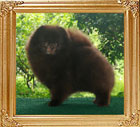MERLES are EXOTIC
Merle Pomeranians are Exotic
Merle Pomeranians are exotic. It is only for those with a certain discriminating taste, for the different and the unique. It is a sporty color having gained popularity in recent years…so popular and so controversial.
In the Philippines, we are not aware of anyone who has this color except us. Because of the newness of this color in the show ring, there are very limited US champions in merles. This proves that the Pomeranian merle can hold their own in competition with the more known and standard colors. We hope to have our own Philippine and foreign Pomeranian champions in merle some day. We hope that judges become more informed about this color and become aware that the AKC Pomeranian Breed Standard allows all colors and states that they should be judged on equal basis. Pictured below are:
- Am Ch Pomebreden Kauai Blue O-Ce-Ann
- Am Ch Honey Bear’s Tybo Express
- Showcase N Bluemoon 501 Blues
- Showcase Blue Diamond at Canton (our import)
- Yingyang Blue Calico(our breeding using the Yingyang suffix)
- Yingyang Casanova of Canton (our breeding)

It has been rationalized that this particular color is not historically and genetically supported by the Pomeranian breed history. It has been alleged that some 30 years ago, somebody cheated resulting in this color. After the N-th generation, we have the merle Pomeranians as we see them today. Personally, I do not find this a big issue at all because this is what has also been done in a lot of other breeds in their initial years. For example, I remember, the Shih Tzu was bred to the Pekingese for lack of Pekingese gene pool. After several generations of breeding, the mix has been integrated to the purebred Pekingese. The same was done for the Shetland Sheepdog; Collies was infused to the Shelties to give them a better look, ie more coat, more bones, more Collie looking in a more miniaturized size. Similar arguments could be used to say that merle Pomeranians are now purebred Pomeranians.
Personally, I do not mix my merle breeding program with my other colors. Once any of my Pomeranian get mixed with the merles, it will forever for merle breeding forever. I do not want any of my breedings of other colors to carry the merle gene. Why? Just like the other purebreds with merle colors, like the Collie, Shetland Sheepdogs, etc, merles is a healthy color provided certain color combinations are NOT done. Just like the other breeds that has this color, breeding merle to merle OR merle to whites MAY cause blindness and deafness.
Since merles is a dominant gene, you need only one merle partner to produce merle puppies. Merles ideally should be bred to:
SOLID COLORS: Blacks, Blues, Chocolates, Lavanders
PATTERNED COLORS: Partis in Black, Blues, Chocolates, Lavanders; Black and Tan, Chocolate and Tan,
Blue and Tan
For those who like the sable merles, then, they can breed them to oranges, reds, and sables but I prefer the pidgeon blue merles which is silver blue grey just like their color equivalent in the other breeds. Chocolate merles are also quite interesting too.
If you apply the Mendelian chart to merles, breeding merles to blacks must produce merles. However, from my experience, you get a lot of blacks; there will be many merles too. Nevertheless, you only need one partner to produce merles. It would seem to me that merle breeding is more complicated than the simple Mendelian Theory. There is a booklet entitled “Sheltie International presents…COLOR INHERITANCE CHART FOR THE SHETLAND SHEEPDOG by Jan and Peggy Haderlie(Summersong Shelties)” which itemizes all the color possibilities for merles.
Merles is not for everyone. But like Collies and Shetland Sheepdogs, provided the color rules (mentioned above) are followed, the health issue becomes academic.










 are LUCKY...
are LUCKY... are SWEET...
are SWEET... are EXOTIC...
are EXOTIC... are MAGICAL...
are MAGICAL...



